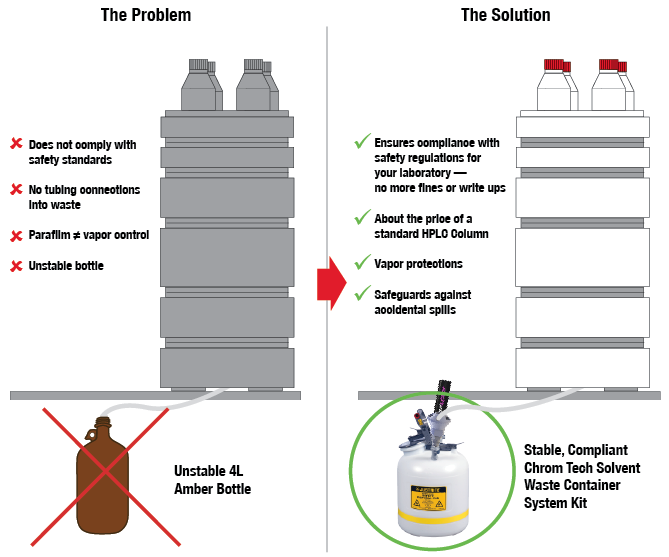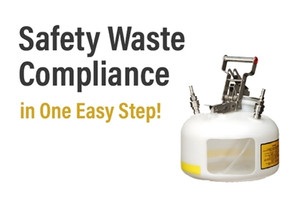Posted by Chrom Tech on 11th Dec 2025
Safety Waste Compliance in One Easy Step
Improper waste collection and handling of hazardous materials can pose serious health and safety risks in any laboratory. While the days of disposing HPLC solvent waste down the drain are long gone, even experienced chromatographers still face challenges when it comes to safe, compliant solvent waste management. Understanding the right equipment and containment procedures is essential for protecting both personnel and property.

The Problem: Unsafe Solvent Waste Practices
It’s not uncommon to find labs using repurposed 4L amber bottles for solvent waste collection, often with tubing inserted through the bottle opening and secured using parafilm. While this may seem like a quick fix, it presents multiple hazards:
- Vapor Leakage – Parafilm and similar materials do not create a true vapor-tight seal, allowing volatile organic compounds (VOCs) to escape into the lab environment.
- Glass Instability – Large glass bottles are easily tipped or broken, creating risks of spills and injuries.
- Regulatory Non-Compliance – Open or improperly sealed waste containers often violate EPA and OSHA laboratory safety standards.
The Solution: Chrom Tech Solvent Waste Container Kit
The Chrom Tech Solvent Waste Container Kit provides a safe, compliant, and easy-to-use waste management solution for HPLC systems. Each kit features a durable Justrite Safety Container (available in 2-gallon or 5-gallon sizes) and includes everything you need for secure solvent waste disposal:
- Reusable Filter Adapter and Organic Vapor Filter – Captures hazardous solvent fumes to protect users from VOC exposure.
- 6-Port Manifold – Accommodates multiple solvent lines for efficient system integration.
- Tubing Connection Kit – Includes fittings and plugs compatible with most HPLC systems for quick setup.
Each system forms a closed waste collection setup, ensuring that solvent vapors are contained while maintaining proper airflow for pressure balance. This design reduces contamination risk, improves safety compliance, and simplifies waste collection for multi-instrument labs.
Don’t Forget Secondary Containment
Even with a secure primary container, laboratories are required to use secondary containment for additional protection against spills or overflows. Chrom Tech offers compatible spill basins specifically designed for use with Justrite waste cans. These secondary containers prevent accidental leaks from spreading, protecting your workspace and equipment.
Protect Your Lab and Stay Compliant
Proper solvent waste handling doesn’t just protect personnel—it ensures compliance with environmental, fire, and laboratory safety standards. The Chrom Tech Solvent Waste Container Kit delivers a turnkey solution that helps maintain a clean, safe, and compliant laboratory environment.
To get started, request a quote or contact our team of specialists for personalized assistance in selecting the right safety waste containment system for your lab.
Frequently Asked Questions About HPLC Solvent Waste Management
Why can’t I use a regular glass bottle for solvent waste?
Glass bottles lack vapor-tight seals and are prone to breakage. This can release hazardous fumes into the lab and create safety violations. Chrom Tech’s solvent waste containers use closed systems that prevent vapor escape and improve stability.
What size solvent waste container should I choose?
Chrom Tech offers 2-gallon and 5-gallon Justrite containers. Choose the size based on the number of instruments connected and the expected solvent waste volume generated in your lab.
Do I need a secondary containment system?
Yes. Regulatory bodies like the EPA and OSHA require secondary containment to prevent accidental spills. Chrom Tech’s spill basins are designed to meet these requirements and fit perfectly with our waste containers.
How does the vapor filter work?
The organic vapor filter captures and neutralizes volatile chemical vapors from solvent waste, significantly reducing lab exposure to harmful compounds and ensuring a safer work environment.

